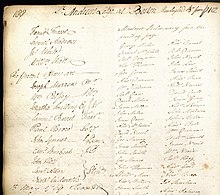Joseph Warren
Rather than exercise his rank, Warren chose to participate in the battle as a private soldier, and was killed in combat when British troops stormed the redoubt atop Breed's Hill.
Warren has been memorialized in the naming of many towns, counties, streets, and other locations in the United States, by statues, and in numerous other ways.
[2][1] While teaching at Roxbury, Warren pursued postgraduate studies at Harvard, graduating with a Master of Arts degree in 1763 after defending a thesis against the proposition that all disease was caused by obstruction of bodily vessels.
[5] While practicing medicine and surgery in Boston, he became involved in politics, associating with John Hancock, Samuel Adams, and other leaders of the broad movement labeled Sons of Liberty.
He was one of the leaders of Patriot activities during the Liberty Affair and facilitated an agreement with Hancock and government customs officials prior to the Boston demonstrations.
Earlier, in 1768, Royal officials tried to place his publishers Edes and Gill on trial for an incendiary newspaper essay Warren wrote under the pseudonym A True Patriot, but no local jury would indict them.
It had been known to rebel leadership for weeks that General Gage in Boston had plans to destroy munitions stored in Concord by the colonials, and it was also known that they would be taking a route through Lexington.
[14] Regardless, Warren learned there was some British expedition likely to begin that night, and so sent William Dawes and Paul Revere on their famous "midnight rides" to warn Hancock and Adams in Lexington.
Now is no time for one of America's children to shrink from the most hazardous duty; I will either set my country free, or shed my last drop of blood to make her so.
"[15] He then turned to recruiting and organizing soldiers for the Siege of Boston, promulgating the Patriots' version of events, and negotiating with Gen. Gage in his role as head of the Provincial Congress.
Three days later, he arrived at Charlestown just before the battle of Bunker Hill began and made his way to where Patriot militiamen were forming.
Warren subsequently volunteered to join the militia at the rank of private against the wishes of both Putnam and Colonel William Prescott, both of whom unsuccessfully requested that he serve as their commander instead.
The man who killed him was possibly Lieutenant Lord Rawdon, who personally recognized him, or by a British officer's servant, an account supported by a forensic analysis conducted in 2011.
[18] Captain Walter Laurie, who participated in the battles of Lexington and Concord, later wrote that he "stuffed the scoundrel with another rebel into one hole, and there he and his seditious principles may remain.
"[19] American soldier Benjamin Hichborn subsequently wrote a letter to John Adams on December 10, 1775, claiming that Lieutenant James Drew, a Royal Navy officer stationed onboard the sloop HMS Scorpion, went to Breed's Hill "a day or two" after the battle and exhumed Warren's body, "spit in his face, jumped on his stomach, and at last cut off his head and committed every act of violence upon his body...
In 1825, it was exhumed and reinterred in St. Paul's Church in Boston before being moved one final time in 1855 to his family's vault in Forest Hills Cemetery.
At the time of Warren's death, his children were staying with his fiancée, Mercy Scollay, in Worcester as refugees from the Siege of Boston.
She continued to look after them, gathering support for their education from John Hancock, Samuel Adams, Mercy Otis Warren, Benedict Arnold, and even the Continental Congress.






